On 9th-10th October, 2019 EverExceed team successfully attended “Data Centre World Singapore-2019” exhibition at Marina Bay Sands which is well renowned as one of the most influential gathering for Data center expertise all around the world.
Approximately 19,000 data center professionals, business leaders, industry practitioners and influencers visited these two consecutive days making the event a formidable success. EverExceed had the great opportunity to meet customers and the general public face to face discussing the modern innovative data center solutions for present and future as well. EverExceed team displayed most energy efficient, highly reliable and easily manageable Data center products and solutions. We presented our new generation Smart IT Cabin solution, Smart IT Data array solution and Smart PDU which are the key products of modern Data center. Besides that, we also displayed our scalable and cost effective modular UPS, UPS lithium batteries, high rate range VRLA and standard range VRLA batteries as an ideal backup power solution for Data center. Our products are highly efficient and can be customized for all kind of small and medium Data centers.

EverExceed's Smart IT Cabin Solution and Smart IT Data Array Solution are the Intelligent and integrated infrastructures ready to house IT in a single cabinet which gained a lot of positive feedback from the crowd. Many visitors also got influenced by our modular UPS which is highly scalable, energy efficient with high ease of use and reliability for modern data centers. The visitors were curious to know about the special features and advantages of these products. Our team was glad to discuss elaborately about our innovative products and solutions with the visitors and explained how our products are most cost effective than others.

It was a successful exhibition to meet and comprehend with so many potential customers all around the world. EverExceed would like to extend a warm “thank you!” to the organizers of the exhibition and the visitors for providing such a fruitful event and inspiring us to build most reliable and energy efficient Data centre solutions.
High frequency UPS:
High frequency UPS is usually composed of IGBT high frequency rectifier, battery converter, inverter and bypass. The IGBT can control its opening and closing by adding control to the gate. The switching frequency of the IGBT rectifier is usually from thousands of Hz to tens of kHz (even up to a hundred kHz) relative to the 50Hz frequency that is far higher than the low frequency UPS, so it is called high frequency UPS.
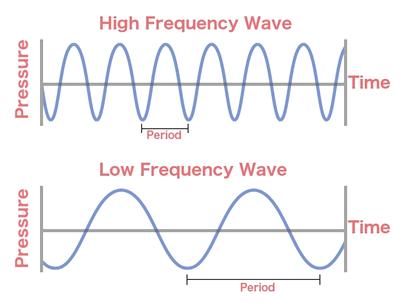
With the development of power electronic technology and high frequency power devices have been developed, the UPS power supply products for small and medium power section also gradually become of high frequency. UPS high frequency power supply has the characteristics of high power density, small volume, light weight, occupy a small space. EverExceed high frequency online UPS power series has the advantages of small size, beautiful appearance, high efficiency, advanced and reliable performance and other advantages in one integrated system and it is praised in the global market as well.
Advantages of high frequency UPS:
When do you need a high frequency UPS?
When users purchase equipment should be based on their actual needs, rather than blindly follow. For example, users want to build in large data centers, then the reliability and stability of the requirements should be the first place, high frequency UPS should be the first choice; if it is a general office applications, or major taking into account the space occupied by the device, you can use high frequency UPS.
EverExceed has different range of online hot swappable high frequency UPS with DSP technology and highly suitable for network and data center. These are not only highly stable but also provide excellent performance as well.
From 25th to 28th, September 2019 EverExceed team successfully attended the 14th Mumbai Industrial Automation Exhibition in India which is Asia's Leading Automation and Instrumentation Exhibition and an ideal platform for the Indian and global automation industry to converge and exhibit cutting-edge technologies, advancements, systems, and services.

During the consecutive 4 days exhibition, it attracted the active participation of nearly 50,000 visitors from 25 countries from all over the world to share their extensive wisdom and discuss the latest concerns of automation industry. This year we represented lead-acid batteries, lithium batteries, modular UPS, Smart IT Cabin and Data Array Solution, rectifier battery charger, solar street light, controllers and other products in this exhibition. Visitors were immensely impressed and many local customers had great interest in our products. The visitors and local buyers were highly influenced by our motive lithium battery which savses OPEX of users comprehensively. They were curious to know about the special features and advantages of the other products also.

We are thankful to the visitors for visiting our booth and inspiring us for the endless effort to build reliable and energy efficient power solutions. It was a successful exhibition to meet and comprehend with so many global customers. Our aim is to build strong professional relationship with the customers and satisfy them by offering world-class products and solution to the rapid growing international market.
What is Solar battery?
Solar batteries are used to store solar energy (solar electricity) and discharge power as and when needed. Rechargeable solar batteries are used in off-grid PV systems to store excess electricity. Now-a-days solar batteries have been specially designed and optimized for PV system. Each battery has different temperature, mounting, and ventilation requirements.
Types of Solar battery
Batteries used in home energy storage typically are made with one of three chemical compositions: lead acid, lithium ion, and saltwater. In most cases, lithium ion batteries are the best option for a solar panel system, though other battery types can be more affordable.
Which one is the best Solar battery?
For solar home energy system, Lead acid battery is still competitive in market due to its less expensive price than Lithium battery. But Lithium ion batteries are the ideal match for solar energy storage because of its longer life span and higher DOD.
What is Solar Lithium (LiFePO₄) battery?
Solar lithium (LiFePO₄) battery adopts lithium iron phosphate technology which is also optimized specially for solar home system. It is an ideal choice for home energy storage system and SME (small medium enterprise). EverExceed designs two types of Solar Lithium batteries- Rack mounted Solar Lithium battery and Wall mounted Solar Lithium battery to meet the demand of both category installation criteria.
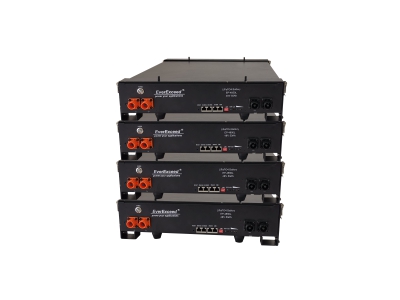 |
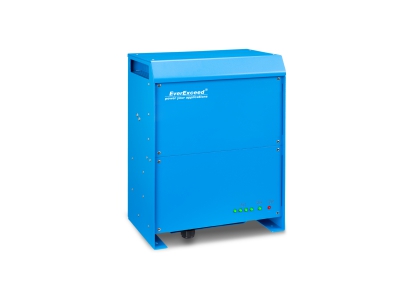 |
| Rack mounted Solar LiFePO₄ Battery | Wall mounted Solar LiFePO₄ Battery |
Technical Features:
•Higher life cycle and longer service life;
•Excellent deep cycle ability;
•Rack mounted battery to install in standard rack.
•Wall mounted battery to save the installation space
•Intelligent monitoring system to check technical parameters;
•Lightweight and high energy density standby power;
•High safety, no risk of explosion fire;
•Maintenance free throughout life time;
•Compatible with most of the available hybrid inverters.
Low voltage:
Voltage (V) is the measure of the potential difference between two points in an electrical field. Low enough voltage to be considered safe for indoor domestic use and typically 120 volts or less.
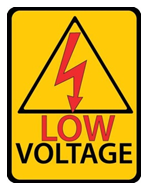
Low voltage UPS:
Uninterruptible power supplies having low voltage are called low voltage UPS. EverExcced offers high efficiency and high quality independent online low voltage UPS which designed in the form of modular UPS, rack UPS and tower UPS. Both single phase and three phase UPS are also available for those countries which use low voltage as well.
In most countries the mains supply is between 220 and 240 volts (50 or 60 Hz); countries that operate on 100-127 volts are greatly outnumbered. There are approximately 40 countries that use 60 Hz while the rest typically run on 50 Hz current. Single-phase power is primarily for residential use (such as homeowners and what you would find in a hotel) while 3-phase electric power provides more stable, heavy-duty power for most industrial applications like manufacturing plants, commercial facilities, data centers, telecom towers, hospitals, food processing, and utility power plants.
Why isn’t there a standard voltage around the world?
Europe and most other countries in the world use a voltage which is twice that of the US. It is between 220 and 240 volts, whereas in Japan and in most of the Americas the voltage is between 100 and 127 volts.
Originally Europe was 120 V too, just like Japan and the US today, but it was deemed necessary to increase voltage to get more power with fewer losses and less voltage drop from the same copper wire diameter. At the time the US also wanted to change but because of the cost involved to replace all electric appliances, they decided not to. At the time (50s-60s) the average US household already had a fridge, a washing-machine, etc., but not in Europe.
USA, Mexico, Colombia, Venezuela, American Samoa, Brazil, Bahamas, Bermuda, Dominican republic, Japan, Ecuador, Honduras, Panama and more other countries are now using low voltage UPS.
In countries having higher voltages, energy losses are lower, but the risk of sustaining injuries is much higher.
One of the biggest threats to batteries is the temperature. It is vital to keep your batteries in conditions that do not affect their chemistry. Unfortunately, getting the right temperature is never easy. Whereas high temperatures are bad, cold temperatures are not good either. Charging a battery above freezing temperature is one of the biggest challenges for European, American and some other countries.
For low temperature operation, EverExceed offers full range of Nickel cadmium batteries and Lithium iron phosphate batteries for variety types of applications.
Nickel Cadmium Batteries
EverExceed Nickel Cadmium Batteries have been designed in such way to cover wide operating temperature range -40°C to +60°C; specially to sustain in low temperature. These batteries also can tolerate extreme of -50°C to +70°C (-58°F to +158°F) for short periods. Our NiCd batteries have injection moulded plastic grids; both separate plate and insulate plate edges. For extremely low temperatures a special high density electrolyte is used. The block battery fitted with a specially designed flame arresting flip top vent and does not produce corrosive vapours.
Benefits:
· 20+years operating life;
· Minimal maintenance
· No downtime
· No replacement cost
Lithium Iron Phosphate Batteries
EverExceed Lithium Iron Phosphate Batteries can be safely discharged over a wide range of temperatures, typically from –20°C to 60°C, which makes them practical for use in all-weather conditions faced by many potentially low temperature applications. For example, at 0°C a lead-acid battery capacity is reduced by up to 20%, while a lithium iron phosphate battery suffers only a 10% loss at the same temperature. When it comes to recharging lithium-ion batteries, however, there’s one hard and fast rule: to prevent irreversible damage to the battery, don’t charge them when the temperature falls below freezing (0°C or 32°F) without reducing the charge current. Charging below 0°C at an inappropriate charge rate causes the battery to become less mechanically stable.
Benefits:
· Higher cycle life at 100%DOD
· Lighter weight to move flexibly
· Mechanically stable
· No sudden death
Rack UPS:
Rack UPS is a power supply equipment mainly used for centralized power supply in security system integration, which is installed on a standard rack and is structured like a server. It is an inevitable product for standardized management and centralized management of security systems.
Diagram of Rack UPS:
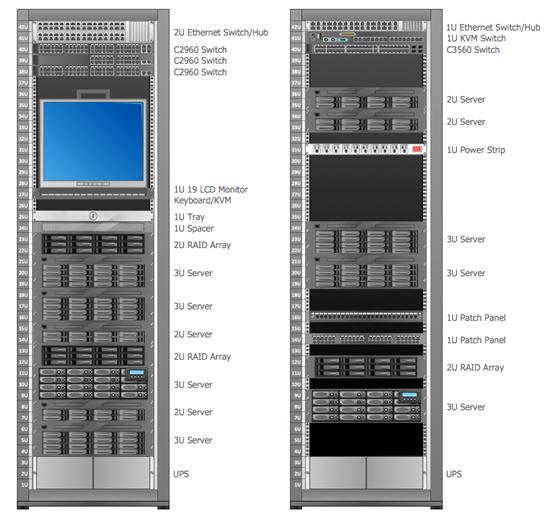
Installation method:
The rack UPS can be fixed in a standard network cabinet through rails. Compared to traditional vertical (tower) UPS, the rack UPS can be installed in a standard cabinet, saving floor space, easy to install, use, maintain and can also use a shorter power connection cable. It increases the availability of the entire system by reducing the point of failure between critical equipment and the load. Just like our Power Lead2 Rack UPS. With 19 inch standard rack design, self-adjusting output frequency, smart battery management system and network management, PL2 RM series is a perfect choice for computers, IT equipments and other sensitive devices.
Advantages of Rack UPS:
The installation is simple, the expansion is convenient and the investment is saved. The rack-mounted UPS power supply enables the power supply system to be on demand, enabling the capacity to grow dynamically with the development of the business which not only meets the expansion requirements of the later business but also reduces the initial acquisition cost of the user. Attractive features are Parallel redundancy, stable operation and high reliability. No need for an electrician or facilities involvement. Ability to do your own maintenance/user serviceable.
Disadvantages of Rack UPS:
Not ideal for mission critical equipment that requires high availability. Takes up valuable rack space and limited battery life (2-3years). Not as efficient as 3 phase UPS. Batteries might not be hot swappable.
Even though a UPS unit is effectively just a sophisticated battery, there are tons of little features that can greatly enhance your UPS experience.
Definition of High Temperature Battery:
High temperature Lead acid battery refers to batteries which are capable to charge continuously at 35°C or above and the operating temperature range is -40°C to +80°C whereas usually the ordinary lead acid battery’s operating temperature range -20°C to +45°C.
High Temperature Battery Design
High Temperature batteries have been designed for countries where temperature is extreme to tolerate (like Middle East , Asian, African countries) and perform simultaneously. These batteries are suitable for Telecommunication, Uninterruptible power supply, Switchgear, Solar/ Photovoltaic, Data Center, Broadband or many more where temperature is the main reason of damaging batteries frequently.
The High Temperature Battery adopts
-Corrosion resistant battery plate to reduce grid corrosion and charge current density,
-nano carbon to improve durability,
-special positive additive α-PbO₂ to improve the grid strength,
-optimized valve to tolerate the internal pressure in high temperature,
-reinforced special high temperature resistant ABS container and cover to ensure stable performance.
Advantages:
•12 years design life @35°C (95°F);
•12 months storage life @20°C~25°C;
•Double floating life more than traditional VRLA battery @35°C;
•Greatly reduce operational cost (more than 60% less cooling consumption);
•Up to 100% air conditioner maintenance saving;
•Up to 100% condensing agent saving;
•Up to 25% electricity power saving;
Market Demand:
There is always a great market demand of high temperature batteries because in hot summer many applications temperature raises up to 75°C. High temperatures cannot always be avoided. As a guideline, each 10°C rise in temperature cuts the life of a sealed lead acid battery in half. Therefore, high temperature batteries are designed and developed to sustain up to 80°C.
What is your opinion about High Temperature VRLA batteries? Do you also agree with us about the technical benefits these batteries? Please let us know your views or queries through message.
With major technological advances, EverExceed Solar Powered Security Camera has been designed with the fundamental of cost benefits and comprehensive surveillance solutions. The systems are highly flexible and offer a range of mounting options and locations. The typical benefits of a traditional CCTV system are far outweighed by the EverExceed solar powered camera security and its unique offering of total independence and control.
Benefits of Solar Powered Security Camera
It's a rough battle to distinguish which one is better between AGM and GEL. AGM batteries and Gel batteries have a lot in common. Both categorized under Sealed Lead-Acid Batteries. Both batteries possess similar traits such as having deep-cycle capabilities, spill-proof design and both can be used in different orientations. The two battery types are also known for their low self-discharge, maintenance free and vibration-resistant characteristics. However, AGM and Gel are two distinctly different types of batteries.
AGM vs GEL
Structure:
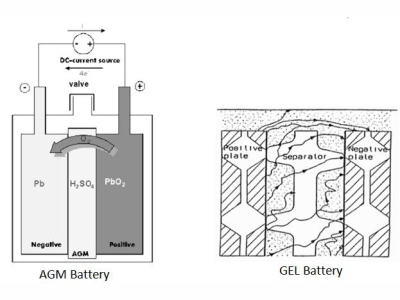
Technical features:
|
Features |
AGM |
GEL |
|
Self-discharge rate |
<3% / month |
<2% / month |
|
Internal resistance |
GEL & AGM |
|
|
Big current discharge ability |
AGM & GEL |
|
|
High temperature life |
GEL & AGM |
|
|
Deep cycle life |
GEL & AGM |
|
|
Separator |
AGM |
AGM/PVC |
|
Electrolyte |
sulfuric acid |
GEL |
|
Electrolyte volume |
AGM = 60%~70% GEL |
|
|
Electrolyte density |
1.30 ~ 1.32g/cm3 |
1.26 ~ 1.28 g/cm3 |
|
Acid Stratification |
Yes |
No |
|
Freezing temperature performance |
AGM & GEL |
|
|
Suitable applications |
A wide variety of applications |
Not suitable as starter battery |
How to choose which battery is suitable:
EverExceed manufactures both AGM and GEL batteries which adopts latest technology. So when trying to decide which battery to purchase consider a few things.
1.What application are you using the battery for?
2.Will the battery have to function in below freezing temperatures or high temperature?
3.How will you recharge the battery?
4.Do you need a slow discharge rate or will you require bursts of power?
Invented more than one a half century ago, the lead-acid battery represents the oldest type of rechargeable battery. Moreover, being quite inexpensive as opposed to newer and high-performance technologies, lead acid batteries are used in a wide range of industries.
Lead acid battery maintenance:
Lead-acid battery industry counts for about 15 billion USD, as well as for up to 45% of the total value of batteries sold worldwide. But properly lead acid battery maintenance could be quite difficult, especially if you are not the expert in the electronics field.
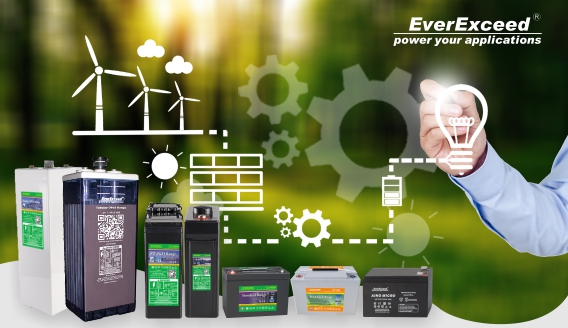
Before getting started:
Before getting started make sure you know its exact system voltage, battery compartment size, as well as your energy requirements.
In addition, you should determine the type of lead acid battery used, choosing from high temperature lead acid battery and deep-cycle flooded ones, to AGM or gel batteries. Choosing the right type of battery is essential for your further energy requirements.
Regular maintenance:
Check your batteries on a regular basis to be sure they are getting charged. Use a hydrometer to check the specific gravity of your lead acid batteries. If batteries are cycled very deeply and then recharged quickly, the specific gravity reading will be lower than it should because the electrolyte at the top of the battery may not have mixed with the "charged" electrolyte. Check the electrolyte level in wet-cell batteries at least four times a year and top each cell off with distilled water. Do not add water to discharge batteries. Electrolyte is absorbed when batteries are very discharged. If you add water at this time, and then recharge the battery, electrolyte will overflow and make a mess.
Keep the tops of your battery clean and check that cables are tight. Do not tighten or remove cables while charging or discharging. Any spark around batteries can cause a hydrogen explosion inside and ruin one of the cells and you.
It is a good idea to do an equalizing charge when some cells show a variation of 0.05 specific gravity from each other. This is a long steady overcharge,bringing the battery to a gassing or bubbling state.Do not equalize sealed or gel type batteries.

Fig: Tools required (Hydrometer, Digital battery testers, Adjustable load testers, Constant rate discharge testers)
Storage specification:
All batteries, no matter their type, should be stored at proper temperatures and in proper conditions. Most batteries require a 15 degrees Celsius temperature, or approximately 59 degrees Fahrenheit.
However, extreme temperatures of up to -40 degree Celsius can be achieved for most chemistry.
Batteries should be fully charged and have the proper electrolyte level. Lead-acid batteries self-discharge over time and will need to be recharged to minimum levels even if they are not connected to a load. This rate of self-discharge varies with temperature -high temperatures increase the discharge rate while low temperatures slow the discharge rate.
How to prolong the battery life time?
To keep lead acid in good condition, apply a fully saturated charge lasting 14 to 16 hours. If the charge cycle does not allow this, give the battery a fully saturated charge once every few weeks. If at all possible, operate at moderate temperature and avoid deep discharges; charge as often as you can.
Safety precautions:
Always use extreme caution when handling lead acid batteries and electrolyte. Wear gloves, goggles and old clothes. The sulfuric acid in lead-acid batteries will burn skin and eyes and destroy cotton and wool clothing.
With proper care, lead-acid batteries will have a long service life and work very well in almost any power system. Unfortunately, with poor treatment lead-acid battery life will be very short.
Battery Charger:
A battery charger ,or recharger is a device to put energy into a secondary cell or rechargeable battery by forcing an electric current through it. The charging protocol depends on the size and type of the battery being charged.
Whether it's your mobile phone, emergency light or the vehicle you own, the extensive use of batteries is evident everywhere. Chargeable batteries are also widely used inverters, where its DC voltage is converted into mains AC voltage and is used to power the household appliances and industries during mains power failure.
Industrial battery charger:
Industrial applications require more ruggedized batteries. Unlike consumer applications, industrial devices are often used in remote, hard-to-reach locations where the device needs to be self-powered and battery replacement and recharging is difficult or impossible. Identifying the ideal power management option is important to these applications because battery failure usually results in failure for the device. As a result, industrial grade batteries must be able to deliver reliable power for as long as the device is able to operate. Some examples include automated utility meters that have to operate up to 25 years outdoors, remote wireless sensors, automotive toll tags, GPS tracking devices, oceanographic instruments as well as process control and monitoring devices used in remote locations. Battery chargers with special features that are subjected to this kind of extreme environmental conditions are called industrial battery chargers.
The importance of battery charger:
A good battery charger provides the base for batteries that are durable and perform well. In a price-sensitive market, chargers often receive low priority and get the “after-thought” status. Battery and charger must go together like a horse and carriage. Prudent planning gives the power source top priority by placing it at the beginning of the project rather than after the hardware is completed, as is a common practice. Engineers are often unaware of the complexity involving the power source, especially when charging under adverse conditions.
Owing to our experience and knowledge in this arena, EverExceed is able to offer our clients an impeccable range of Industrial Battery Charger that is precision engineered with the industry laid standards and guidelines. Offered range is acknowledged in the market for their attributes like robust construction, durable standards and optimum performance.
Technologies improve and chargers change. That is why you always need to read the manual included with the charger and follow the instructions stated within.
Before starting to use your new battery charger, it is important to check the input voltage. This is especially needed in case of a conventional charger. High frequency chargers adjust to this automatically. If you don't do this, there is a chance that you will damage the charger.
E.g. if the input voltage is 230 V, you can set it accordingly and correctly connect it to 230 V.
A solar security camera system has the unique ability to be used as a video monitoring systems in wide open, outdoor areas devoid of any power lines and electrical outlets. Whether you’re looking for a security camera to reach a difficult area or want an environmentally friendly option, solar powered security cameras are a great option. Before buying a solar powered security camera, it’s important to understand how they work so that you can make the right decision for your security needs.
What are solar powered security cameras?
Solar powered security cameras, also commonly referred to as solar panel security cameras harness the sun’s energy to power the compatible security camera.
How do solar powered security cameras work?
Solar powered security cameras use solar panels to harness the sunlight and convert that sunlight into direct current (DC) electricity. An inverter then transitions the direct current to an alternating current (AC), which can then be used to power the security cameras.
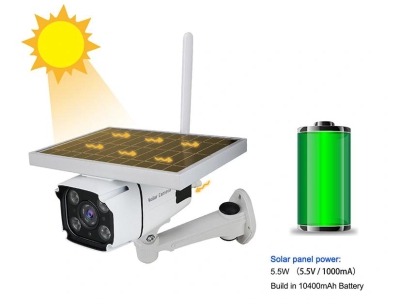
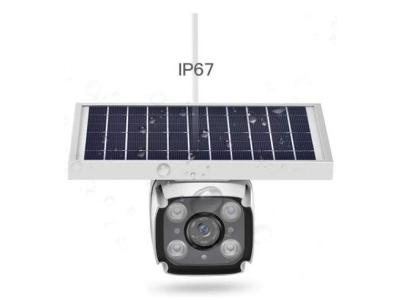
What kind of Solar Security Cameras EverExceed offers?
EverExceed offers most advanced and affordable weatherproof outdoor solar cameras which support both wifi and 4G network to ensure trouble free operation with high resolution 1080P video, durable construction and powerful mobile app that enables you to view live footage and speak to anyone within range of the camera. It has impressive 145° field of vision along with motions detection keep you update with instant alert notification.
What happens when it rains or is overcast – do solar powered security cameras work?
EverExceed Solar Security Cameras adopt IP67 technology to withstand snow, rain, dust, and direct sunlight keeping your property protected year round. The cameras also come with built in 5200mAh x 2 (10400mAh) lithium batteries to provide alternative backup power. The monocrystalline solar panel not only powers the security camera but also recharges the batteries.
Solar powered security cameras help you keep a close eye on your yard without paying for the increased electric bill that comes along with traditional cameras. There are many high-quality options out there but it depends on you whether you choose to be a part of using sustainable clean energy or not. The more use of solar power, the more green our environment will be.
Deep cycle battery:
A deep-cycle battery is a battery designed to be regularly deeply discharged using most of its capacity.
Deep cycle batteries are designed to be discharged down as much as 80% time after time and have much thicker plates. The major difference between a true deep cycle battery and others is that the plates are SOLID Lead plates - not sponge. This gives less surface area, thus less "instant" power like starting batteries need. Although these can be cycled down to 20% charge, the best lifespan vs cost method is to keep the average cycle at about 50% discharge.
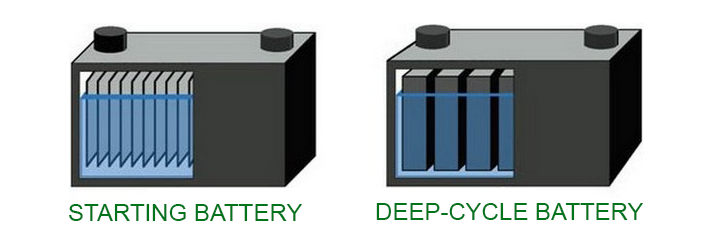
The level of discharge is the “deep cycle” and stands in contrast to other types of batteries that provide only short bursts of energy before they need to be recharged. To be specific, a starter battery discharges only a tiny percentage -- usually 2 to 5% -- each time it is used.
Types of deep cycle battery:
Even among deep cycle batteries with similar functionality, there are different types. The two most common types of deep cycle batteries are flooded deep cycle batteries and sealed or “maintenance-free” deep cycle batteries. Further, flooded deep-cycle batteries can be divided into subcategories of Tubular-plated or flat plated. The difference generally affects the cycle life and performance of the cell.
Flooded deep cycle batteries require regular monitoring. When the electrolyte levels are low in this type of battery, the user must refill the battery appropriately to maintain performance. EverExceed Deep Cycle AGM battery and Deep cycle GEL battery are perfectly suited for float and cyclic application under extreme environment. EverExceed Tubular-plated OPzS range battery are popular for long durability, high reliability and low maintenance.
“Maintenance-free” batteries, which are also called “Sealed” or “Valve Regulated Lead Acid” batteries are sealed and do not require watering, although regular inspection is still recommended.
Although still much more expensive than traditional lead-acid, a wide range of rechargeable battery technologies such as lithium-ion are increasingly attractive for many users. Such as EverExceed Deep Cycle LDP Series Lithium Iron Phosphate (LiFePO4) Battery are developed to deliver high efficiency energy output compared to equivalent lead acid batteries.
When to use a deep cycle battery?
Deep cycle batteries provide sustained energy, making them ideal for certain applications that require more than a quick start. Some of the most common uses for deep cycle batteries include:
EverExceed has excellent deep cycle life and maintenance free AGM, Gel Lead Acid batteries and environment friendly Lithium batteries designed for frequent cyclic charge and discharge applications under extreme environments. These batteries perfectly fulfill the requirement for many different applications including telecommunications, medical equipment, industrial and utility applications where frequent deep cycles are required and minimum maintenance is desirable.
a)What are the important and necessary kits that a solar camera consists of?
1.Solar Panel
2.Built in battery
3.A camera
4.SD card
5.Antenna
Solar panel: The best quality solar panel which maximizes the efficiency and performs in low light is ideal for a security camera. While choosing camera it’s also important to look into the types of solar panel. Choosing monocrystalline solar panel will be wiser than polycrystalline solar panel.
Battery: The life span of solar camera depends on the life of the battery. Its battery must have long cycle life, fast and deep discharging capability. It must have a high speed charging and extremely low self discharge. It must be resistant to vibration as well as a wide operating temperature range. Lithium iron Phosphate (LiFePO4) battery is the best choice for longer service life.
Camera: The camera is the most vital part itself consisting with 2.0 megapixels 1080P HD quality, two way intercom, induction lump, IR technology, motion sensor and weather protective body.
SD card storage: The solar powered security cameras with SD card (slot) can record motion detection events onboard even when there is no WiFi / Internet. So SD card slot is important to include in choosing solar camera. SD cards that supports up to 64GB is considerable to store data while network is absent.
Antenna: The solar power camera is wireless and runs by internet whether it is wifi or 4G network. The antenna simply activates the camera by connecting with wireless network.

b)What are the special features that make a solar camera complete surveillance system?
1.Weather protection
2.Built in charge controller
3.Intercom
4.HD video Quality
5.Night vision
6.Remote control
7.Motion sensor
Weather protection: Choose the solar security camera which offer good IP rating (EverExceed offers IP67 ) and can withstand heavy rainfall, hailstorms, gusty winds, snowfall, sleet, fog, haze, mist, smog and pollen.
Built-in charge controller: Pick the solar security camera that has a built-in microcontroller for digital accuracy. It must be able to detect day and night using the PV array. It must operate fully automatically. It must have LVD (low voltage disconnect) override protection.
Intercom: Select the ones which have two way intercom. This feature will help you to talk both way to the visitors on your doorstep, while you are busy inside your house. You can also warn from other side if any unexpected thing happens.
High definition video quality: Remember the higher the camera resolution, the sharper the images. 1080P and higher resolution are ideal for the best and clearest view. HD 1080P also ensures clear view even in night to identify the subject.
Night vision: This is the most important thing to consider. To get the best night view, select a solar security camera with an infrared technology (IR). IR sends bright light through wavelengths. The number of infrared LEDs used in your camera will determine how far it can see. Buy the one with a built-in IR cut-switch that automatically enables and disables the IR depending on the lighting conditions.
Mobile remote control: Pick the solar security camera that is able to live stream feed directly to your smartphone or ipad. If you go away for holidays, this feature will keep you aware and carefree. Make sure the camera is compatible with your specific smartphone or ipad.
Motion sensor: Last but not the least is motion sensor. It helps to send you instant alert message to know what is happening outside. The most important advantage is that it saves energy of solar camera. During night if there is no movement the camera will go to sleep mode automatically and if there is any movement it wakes up automatically and starts recording. Microwave motion sensor provides you the most accurate detection and it is ideal for wide open space.
Power outages are one of telecom companies’ worst nightmares, as they lead to loss of revenue, customers, image, and so on. In response, internet and telephone providers have expressed a keen interest in having a power backup system. There is a wide choice for telecom companies regarding which backup system they want such as diesel and natural gas generators, fuel cells and batteries.
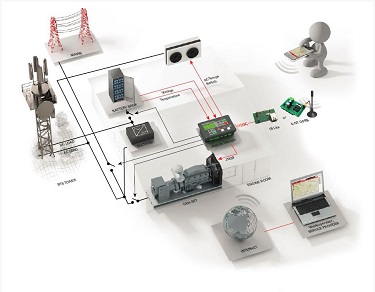
Types of batteries used for telecommunication:
Batteries convert chemical energy directly into electrical energy. Telecom power systems are responsible for every-day internet, high-speed data, telephone, and other communication services. As global demand for these services continues to increase, the need for reliable wireless telecom battery backup equipment rises. The batteries used in telecom sector are mainly two types:
The majority of batteries used in the telecom industry are a Lead-Acid type. The lead-acid battery segment contributed the majority of shares toward the battery market in telecommunication industry. Lead-Acid batteries are an inexpensive design compared to newer technologies such as Lithium-Ion; however, Lead-Acid batteries have a lower energy density, meaning that larger and heavier batteries are required to produce the same power equivalence of a smaller, Lithium-Ion battery.
Valve-regulated (commonly referred to as sealed) lead-acid batteries are normally used as the backup power source for telecom power systems, due to their low operating costs. The battery string is comprised of 24 series-connected battery cells to make 48V. The battery plants are normally designed to support the telecom load to a final battery voltage of 1.75~1.8V/cell.
In the other hand, Li-ion batteries have definite technical advantages in terms of power to weight to volume ratio, absence of pollutants like acid and lead. Lithium-ion or Li-ion batteries have more than double life than of traditional lead-acid batteries and thus help to cut cost. Lithium-ion (Li-ion) — Telecom systems need small power sources to back-up the supply to mobile-phone relay stations, cable TV terminals and other facilities. Because these power systems need to be small and lightweight, they need to use batteries with an energy density higher than that of VRLA batteries.
Important criteria while choosing battery backup:
Among several kinds of lead acid batteries, some models are usually designed or chosen specially for Telecom market to ensure maximum performance according to the load capacity. Here is some important criteria while choosing battery:
• Special design comply with telecom 19''/ 23'' cabinet for space limitation;
• Deep cycle ability and high cycle life;
• Wide operating temperature range as well as high temperature sustainability;
• Maintenance free battery for trouble free operation in remote site;
• Negligible gassing ;
• Spill proof and leak proof ;
• Scalable;
• Operation in any suitable position;
• Compatible with off-grid energy storage system.
In compatible with the above criteria EverExceed offers an extensive portfolio of Modular Range VRLA battery, Modular Max range VRLA, Front access FT range VRLA, Front access FT Gel range VRLA, Unilyte range VRLA, High rate range VRLA, Standard range VRLA, Tubular OPzV range VRLA, Flooded Tubular OPzS and Lithium Iron batteries as well as rectifier system to serve the telecommunications industry. Our batteries are featured with excellent deep cycle ability, wide operating temperature range, long life, compact footprint, high energy density and ease of installation. The design of the batteries and rectifier system are ideally suitable for a wide range of wireless telecom applications, including indoor and outdoor BTS.
Take EverExceed Solar Powered Security Camera which is a great choice for those who want to keep their home secure without raising their electricity bill. It is a self sufficient system that comes with a rechargeable Lithium Iron Phosphate battery and offers a high grade monocrystalline solar panel to get non-stop power. When the sunlight is not available, the wireless solar powered security cameras can still get power from the rechargeable batteries which stores excess electrical power generated by the solar panel.
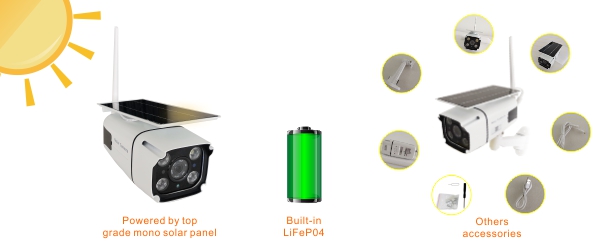
Working principal:
One of the top benefits is that you can install a solar security camera anywhere you wish. In rainy or foggy days, the WiFi solar security cameras can still work as normal – sufficient sunlight is absolutely the best! Since the EverExceed Solar Security Camera comes with the weatherproof design, you don't need to worry about them in rainy days.
Lithium Iron Phosphate battery:
Lithium Iron Phosphate Battery is a rechargeable types of battery which features lithium ions that moves from the negative electrode to the positive electrode during discharge and comes back to its original points while charging.
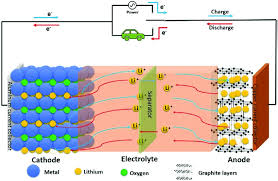
Fig: Schematic of working mechanism of Lithium-iron phosphate battery
Advantages of Lithium Iron Phosphate (LiFePO4) battery:
Smaller and lighter: Lithium Iron Phosphate (LiFePO4) battery is lighter than other rechargeable batteries in consideration of battery capacity. This makes it more practical in portable consumer electronic devices in which physical specifications such as weight and form factor are considered important selling points. Generally lithium battery weight is 30% from the lead acid batteries.
High efficiency: Most lithium-ion batteries have more than 95% efficiency (in 1C discharge), meaning that 95 percent or more of the energy stored in a lithium-ion battery is actually able to be used in 1C discharge. Conversely, lead acid batteries see efficiencies closer to 50% in 1C discharge.
Fast charging ability: Lithium batteries have superior fast charging ability over Lead acid batteries. With appropriate battery charger, then can be 90-100% charged within 1-3hours where as general lead acid batteries take more than 10-12 hours to fully charge.
High energy density: This is one of the highlighted advantages of lithium iron phosphate battery technology. With the increased density of energy this battery technology is being used from smart phones to the high end electric vehicles. The theoretical energy density of lead acid is 35-50 Wh/kg where as lithium batteries have usually 120-260Wh/kg.
Depth of discharge: Lead-acid batteries should only be run to 50% depth of discharge. Beyond that point, you risk negatively affecting their lifespan. In contrast, lithium batteries can handle deep discharges of 80% or more. This essentially means they feature a higher usable capacity.
Self-discharge: Other rechargeable batteries are not good with the rate of self-discharge. Due to the existence of Lithium iron cells in the battery the self-discharge rate is quite lower than others. It is around 5% for the first four hours and drops to around 1-2% per month.
Low maintenance: It does not require constant maintenance to continue its flawless performance whereas Lead-acid is a tried-and-true technology that costs less, but requires regular maintenance and doesn’t last as long.
Availability of variety: There are several types of lithium ion cells which can be used accordingly as per the requirement for a particular application.
Zero to low memory effect: Lithium Iron Phosphate (LiFePO4) battery has zero to minimal memory effect. This memory effect is common in nickel-metal hydride rechargeable batteries such as NiCd and NiMH.
High open-circuit voltage: Lithium Iron Phosphate battery has a chemistry that results in higher open-circuit voltage than other aqueous batteries such as lead acid, nickel-metal hydride, and nickel-cadmium.
The Lithium Iron Phosphate Battery have eventually become popular and its demand has drastically grown up to much greater extent in past few years. There are various lithium iron phosphate battery manufacturers who have been producing such batteries to fulfill the needs as per the demand and fill the gap between the demand and supply. But we need to understand the advantages and the limitations of this technology for choosing the right backup battery for us.
درباره این سایت